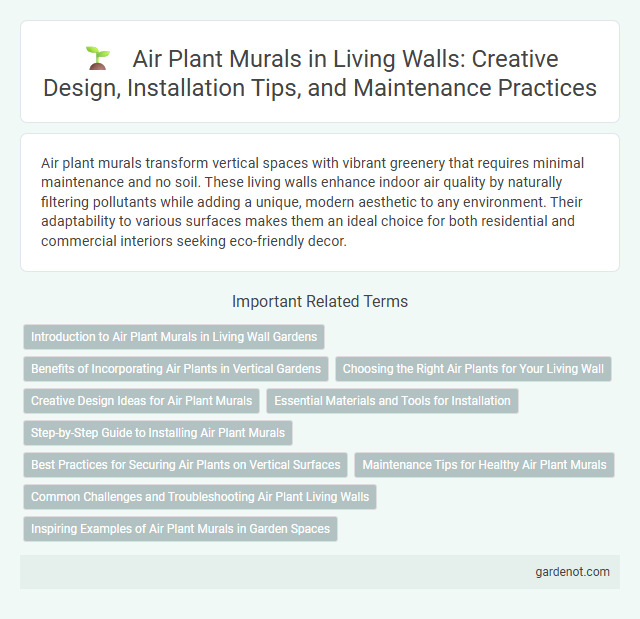Air plant murals transform vertical spaces with vibrant greenery that requires minimal maintenance and no soil. These living walls enhance indoor air quality by naturally filtering pollutants while adding a unique, modern aesthetic to any environment. Their adaptability to various surfaces makes them an ideal choice for both residential and commercial interiors seeking eco-friendly decor.
Introduction to Air Plant Murals in Living Wall Gardens
Air plant murals transform living wall gardens by integrating Tillandsia species known for their ability to thrive without soil, making them ideal for vertical installations. These plants absorb moisture and nutrients through their leaves, enabling creative and low-maintenance designs that enhance indoor air quality. Incorporating air plant murals adds a dynamic, textural element that promotes natural aesthetics and sustainable living environments.
Benefits of Incorporating Air Plants in Vertical Gardens
Air plant murals enhance vertical gardens by improving indoor air quality through natural air purification and humidity regulation. These low-maintenance plants require no soil, making them ideal for space-saving and eco-friendly design solutions. Their unique ability to absorb nutrients from the air supports healthier environments and adds visual interest with minimal care.
Choosing the Right Air Plants for Your Living Wall
Selecting the right air plants for your living wall involves considering species such as Tillandsia ionantha, Tillandsia xerographica, and Tillandsia caput-medusae, known for their adaptability and striking appearance. These air plants thrive in well-ventilated spaces with indirect sunlight and require minimal watering, making them ideal for vertical murals. Proper selection ensures longevity and vibrant growth, enhancing both the aesthetic and air-purifying benefits of your living wall.
Creative Design Ideas for Air Plant Murals
Air plant murals transform walls into vibrant, low-maintenance green art by integrating Tillandsia species in unique patterns and geometric shapes. Creative design ideas include combining various air plant types with natural elements like driftwood, stones, or moss to enhance texture and visual interest. Using modular frames or hexagonal grids allows for customizable arrangements that bring dynamic, living installations to indoor and outdoor spaces.
Essential Materials and Tools for Installation
Essential materials for an air plant mural installation include a sturdy backing board like reclaimed wood or metal mesh, non-toxic adhesive or floral wire for securing the plants, and moisture-retentive moss or sphagnum to support plant hydration. Tools required involve a hot glue gun, wire cutters, and mounting brackets or hooks to ensure stable wall attachment. Proper ventilation and access to indirect light are critical for maintaining air plant health within the mural.
Step-by-Step Guide to Installing Air Plant Murals
Begin by selecting a sturdy, moisture-resistant backing such as wood or metal to support the air plant mural's weight and ensure durability. Arrange the air plants on the backing in a visually balanced layout, securing them with non-toxic adhesive or wire to avoid damaging the delicate roots. Hang the completed mural in a location with indirect sunlight and provide regular misting or soaking to maintain optimal humidity for air plant health.
Best Practices for Securing Air Plants on Vertical Surfaces
Use non-toxic adhesives such as hot glue or silicone-based gels to securely attach air plants to vertical surfaces without damaging their delicate structures. Incorporate lightweight frames or mesh backing to provide additional support and ensure proper airflow around each plant, promoting healthy growth. Arrange air plants spaced adequately for light exposure and easy maintenance, preventing moisture buildup and rot in your living wall.
Maintenance Tips for Healthy Air Plant Murals
Air plant murals thrive with proper care, including bright, indirect light and weekly misting to maintain optimal humidity. Soaking the air plants in water for 20-30 minutes every two weeks helps prevent dehydration and promotes healthy growth. Regularly removing dead leaves and ensuring good air circulation are essential maintenance practices for vibrant, long-lasting air plant murals.
Common Challenges and Troubleshooting Air Plant Living Walls
Air plant murals often face challenges like inconsistent watering, inadequate airflow, and insufficient light, which can lead to plant stress or rot. To troubleshoot, ensure regular misting or soaking with proper drainage, position the mural in bright indirect sunlight, and maintain good ventilation to prevent fungal growth. Monitoring humidity levels and inspecting for pests also helps sustain a healthy air plant living wall.
Inspiring Examples of Air Plant Murals in Garden Spaces
Air plant murals create dynamic living walls by integrating Tillandsia varieties, which thrive without soil and require minimal maintenance, making them ideal for vibrant garden displays. Notable examples include vertical installations using mixed air plant species to add texture and color against wooden or metal backdrops, enhancing both indoor and outdoor garden aesthetics. These murals promote air purification and unique biophilic design, transforming ordinary garden spaces into lush, eco-friendly art statements.
Air plant mural Infographic

 gardenot.com
gardenot.com